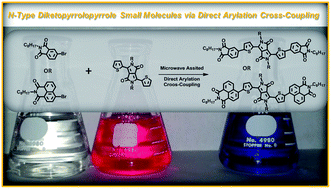Electron deficient diketopyrrolopyrrole dyes for organic electronics: synthesis by direct arylation, optoelectronic characterization, and charge carrier mobility†
Abstract
Four electron deficient small molecules based on the diketopyrrolopyrrole (DPP) chromophore were synthesized using microwave-assisted direct arylation reactivity. These molecules are based upon an acceptor–donor–acceptor–donor–acceptor (A1–D–A2–D–A1) framework, where DPP is utilized as the central acceptor (A2) unit. We compared the effect of naphthalimide vs. phthalimide terminal acceptors (A1), and different DPP (A2) alkyl groups, on the optical, thermal, electrochemical and electronic properties. A combination of absorption and emission spectroscopy, differential scanning calorimetry, thermal gravimetric analysis, cyclic voltammetry, ultraviolet photoelectron spectroscopy, charge carrier mobility, and DFT calculations were used to characterize the four materials. All compounds were found to have narrow band-gaps, deep HOMO/LUMO levels, and were able to effectively act as electron transport materials.


 Please wait while we load your content...
Please wait while we load your content...